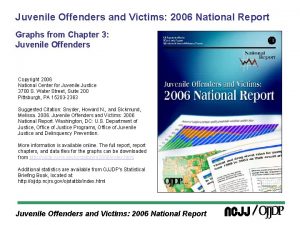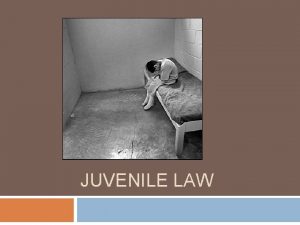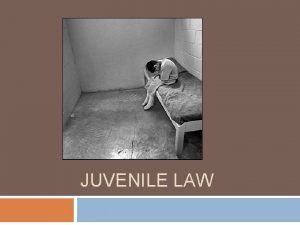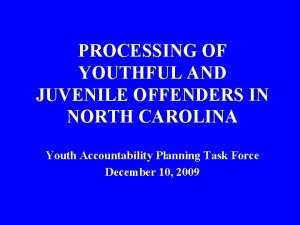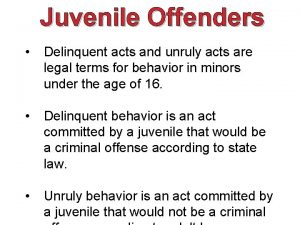Juvenile Offenders and Victims 2006 National Report Graphs































- Slides: 31

Juvenile Offenders and Victims: 2006 National Report Graphs from Chapter 7: Juvenile Offenders in Correctional Facilities Copyright 2006 National Center for Juvenile Justice 3700 S. Water Street, Suite 200 Pittsburgh, PA 15203 -2363 Suggested Citation: Snyder, Howard N. , and Sickmund, Melissa. 2006. Juvenile Offenders and Victims: 2006 National Report. Washington, DC: U. S. Department of Justice, Office of Justice Programs, Office of Juvenile Justice and Delinquency Prevention. More information is available online. The full report, report chapters, and data files for the graphs can be downloaded from http: //ojjdp. ncjrs. gov/ojstatbb/nr 2006/index. html Additional statistics are available from OJJDP's Statistical Briefing Book, located at: http: //ojjdp. ncjrs. gov/ojstatbb/index. html Juvenile Offenders and Victims: 2006 National Report

In 2003, public and private facilities held 32% more delinquents and 32% fewer status offenders than in 1991 Juvenile Offenders and Victims: 2006 National Report

Public facilities drive the trend for the delinquency population; private facilities drive the trend for status offenders Juvenile Offenders and Victims: 2006 National Report

Between 1991 and 2003, the detained delinquency population in public and private facilities increased 38% Juvenile Offenders and Victims: 2006 National Report

The number of committed delinquents held in public or private facilities as part of a court-ordered disposition was 28% greater in 2003 than in 1991 Juvenile Offenders and Victims: 2006 National Report

In 2003, the national detention rate was 83 juvenile offenders in custody for every 100, 000 juveniles in the population Juveniles detained in residential placement per 100, 000 in the population Juvenile Offenders and Victims: 2006 National Report

In 2003, the national commitment rate was 219 juvenile offenders in custody for every 100, 000 juveniles in the population Juveniles committed to residential placement per 100, 000 in the population Juvenile Offenders and Victims: 2006 National Report

Although national custody rates declined from 1997 to 2003, not all states experienced a decline Juvenile Offenders and Victims: 2006 National Report

More than half of the states had lower commitment rates in 2003 than in 1997 Juvenile Offenders and Victims: 2006 National Report

New Hampshire, Oregon, and Colorado had the highest proportions of person offenders in the custody population; Mississippi, Nebraska, and Wyoming had the lowest Percent of juvenile offenders held for person offenses Juvenile Offenders and Victims: 2006 National Report

Massachusetts and North Carolina had the highest proportions of person offenders among detained juveniles; Connecticut and Mississippi had the lowest Percent of detained juvenile offenders held for person offenses Juvenile Offenders and Victims: 2006 National Report

Oregon and New Hampshire had the highest proportions of person offenders among committed juveniles; Mississippi, Nebraska, and Wyoming had the lowest Percent of committed juvenile offenders held for person offenses Juvenile Offenders and Victims: 2006 National Report

The number of male offenders in custody increased 23% from 1991 to 2003 Juvenile Offenders and Victims: 2006 National Report

The number of female offenders in custody increased 52% from 1991 to 2003 Juvenile Offenders and Victims: 2006 National Report

In nearly all states, females represented a relatively small proportion of juvenile offenders in residential placement in 2003 Female proportion of juveniles in custody Juvenile Offenders and Victims: 2006 National Report

Between 1991 and 2003, detained youth constituted about onequarter of all male delinquents in residential placement Juvenile Offenders and Victims: 2006 National Report

Between 1991 and 2003, detained youth constituted more than one-third of all female delinquents in residential placement Juvenile Offenders and Victims: 2006 National Report

In every state except Vermont, the custody rate for black juvenile offenders exceeded the rate for whites Ratio of minority custody rate to white rate Juvenile Offenders and Victims: 2006 National Report

Ratio of minority rate to white rate for detained offenders in 2003 Juvenile Offenders and Victims: 2006 National Report

Ratio of minority rate to white rate for committed offenders in public facilities in 2003 Juvenile Offenders and Victims: 2006 National Report

In 2003, 34% of committed offenders but just 3% of detained offenders remained in placement 6 months after admission Juvenile Offenders and Victims: 2006 National Report

Males tended to stay in facilities longer than females in 2003 Juvenile Offenders and Victims: 2006 National Report

Half of detained white offenders remained in custody after 14 days; half of detained minority offenders remained in custody after 15 days Juvenile Offenders and Victims: 2006 National Report

2003 time-in-placement patterns largely overlapped for detained youth held for property, drug, public order, and status offenses Juvenile Offenders and Victims: 2006 National Report

In 2003, committed person offenders were in placement longer than other types of offenders Juvenile Offenders and Victims: 2006 National Report

Compared with youth in the general population, at all ages, higher proportions of youth who are reentry candidates are themselves parents Juvenile Offenders and Victims: 2006 National Report

On a typical day in 2004, about 7, 000 persons younger than 18 were inmates in jails in the U. S. —most were held as adults Juvenile Offenders and Victims: 2006 National Report

Between 1996 and 2002, the number of new admissions of youth younger than 18 to state prisons fell 45% Juvenile Offenders and Victims: 2006 National Report

The population of older inmates grew 16% between 1997 and 2004 Juvenile Offenders and Victims: 2006 National Report

The population of inmates younger than age 18 fell 54% between 1997 and 2004 Juvenile Offenders and Victims: 2006 National Report

Although 20 states had death penalty provisions for offenders age 17 or younger when Roper v. Simmons was decided in 2005, few applied those provisions Juvenile Offenders and Victims: 2006 National Report
 Juvenile offenders comprehension check answers
Juvenile offenders comprehension check answers Under 15 years old
Under 15 years old Good and bad state graphs in software testing
Good and bad state graphs in software testing Graphs that enlighten and graphs that deceive
Graphs that enlighten and graphs that deceive Borstal institution meaning
Borstal institution meaning Cognitive behavioral therapy for sex offenders
Cognitive behavioral therapy for sex offenders Juvenile delinquents act canada
Juvenile delinquents act canada Cognitive behavioral therapy for sex offenders
Cognitive behavioral therapy for sex offenders Individual delinquency
Individual delinquency Youthful offenders act 1854
Youthful offenders act 1854 Speed and velocity
Speed and velocity End behavior of polynomials
End behavior of polynomials Jim rose review
Jim rose review West memphis 3 victims autopsy
West memphis 3 victims autopsy Brenda judd and sandra colley
Brenda judd and sandra colley Tinning marybeth
Tinning marybeth Canadian centre for victims of torture
Canadian centre for victims of torture Unit 2 fashion victims answers
Unit 2 fashion victims answers Stephen schafer victim typology
Stephen schafer victim typology Explain two contrasting understandings of salah
Explain two contrasting understandings of salah Two man carry human crutch
Two man carry human crutch Bls study guide
Bls study guide Religious beliefs about helping victims of war
Religious beliefs about helping victims of war Brandon crunkilton
Brandon crunkilton Richard vampire
Richard vampire Ideas have consequences bad ideas have victims
Ideas have consequences bad ideas have victims Hyatt skywalk collapse
Hyatt skywalk collapse Three tiers of support for second victims
Three tiers of support for second victims Von hentig's psychological types of victims
Von hentig's psychological types of victims What is victimology
What is victimology Thourghout
Thourghout Characteristics of the victims of muti murders
Characteristics of the victims of muti murders

































